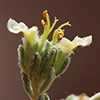Teucrium leucocladum is a desert sub-shrub, canescent and wooly, 15-30 cm in height, and intricately branched. The stems and branches are round in cross-section, and the ends of the branches become bare and spinescent after flowering. The leaves are small, at most 1 cm in length, elliptical or obovate in shape. Margins are strongly crenate and slightly revolute.
The inflorescence is arranged in a head borne on a short branch. Its diameter does not exceed 1 cm. The flowers are nearly sessile. The calyx is bell-shaped and about 3 mm in length. The corolla is white or cream colored. The flower has four stamens, which protrude from the tube of the corolla.
T. leucocladum grows in rocky ravines in the southern Negev and Arava and flowers during the summer months.
The genus ‘Teucrium’ contains approximately 300 species, with almost worldwide distribution. The genus is characterized by a flower corolla composed mainly of a single, lower lip (palate). More precisely, the upper lip of the corolla (hood) is reduced so that it is very short and hidden within the calyx. The lower lip of the corolla is divided into five lobes: the central one is large and concave, and the others are elongated. The various species of this genus are mostly pollinated by bees.
The Hebrew name is derived from the Arabic word for ‘curly’ because of the appearance of the leaves in some of the species. The Latin name refers to King Teucer of Troy, who supposedly have recognized the medicinal properties of the plant.
Written by Leorah Kereth




